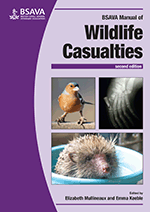
Full text loading...

Pigeons and doves are the most common avian species presented to wildlife rehabilitators, either as injured birds or as ‘orphaned’ young. These birds pose a considerable health risk to humans, particularly from zoonotic diseases salmonellosis and chlamydiosis, so careful handling and hygiene practices are necessary. This chapter covers: ecology and biology; anatomy and physiology; capture, handling and transportation; clinical assessment; first aid and hospitalization; anaesthesia and analgesia; specific conditions; therapeutics; husbandry; rearing of young pigeons and doves; rehabilitation and release; and legal considerations.
Pigeons and doves, Page 1 of 1
< Previous page | Next page > /docserver/preview/fulltext/10.22233/9781910443316/9781910443316.28-1.gif

Full text loading...













